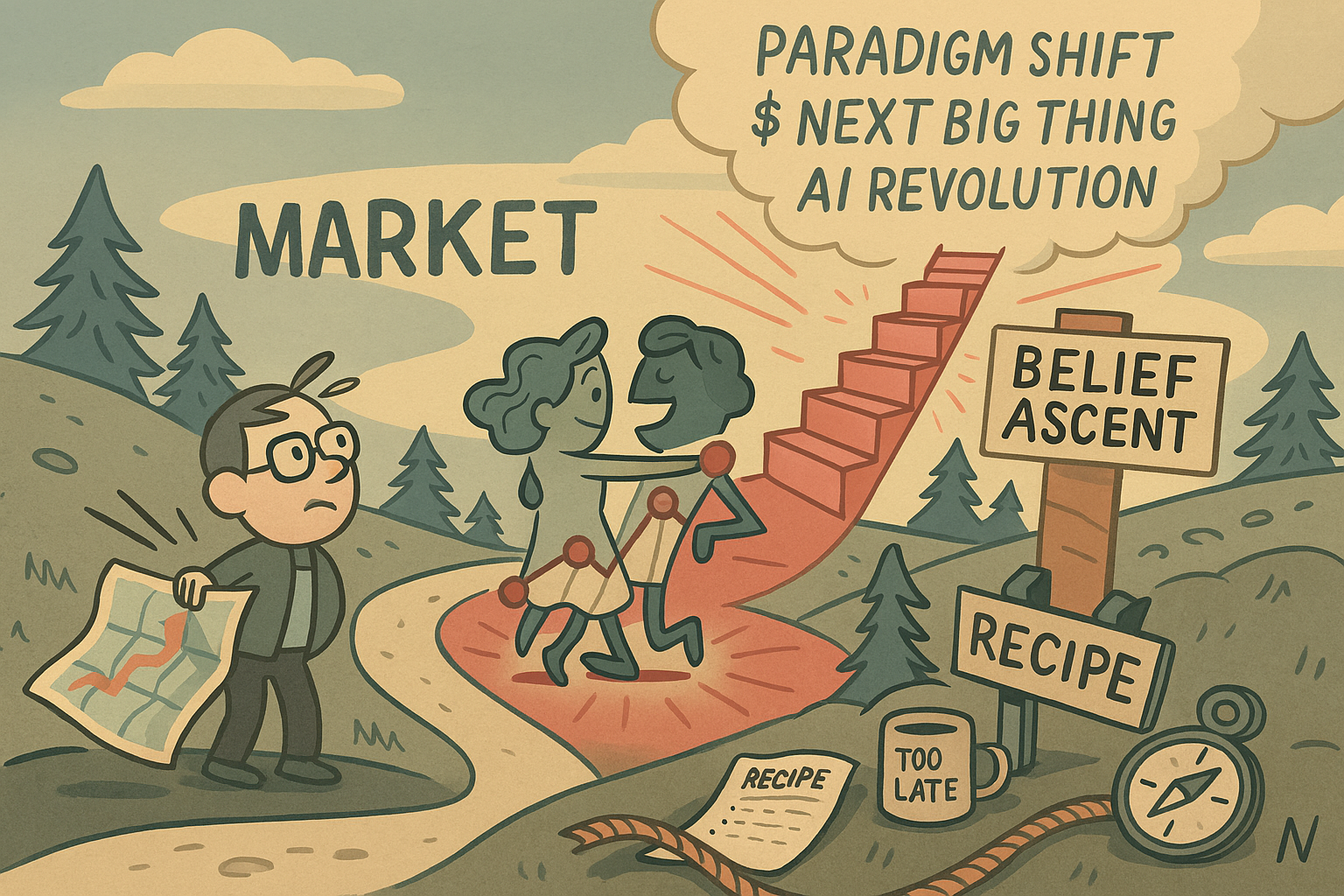When the Market Ignores the Map: Valuation, Impulse, and the Power of Story
October 2025
In certain market phases, price movements seem to drift away from the usual rules. A stock climbs far beyond what traditional valuation models would suggest. Investors who rely on those models may decide to sell, believing the price has reached its peak—only to watch it keep rising.
This isn’t necessarily a mistake. It’s a sign that the market has shifted from what we might call map mode to story mode.
Map Mode vs. Story Mode
In map mode, investors navigate using familiar tools: earnings, growth rates, price-to-earnings ratios. The terrain is logical, and decisions follow a clear path. Price moves in response to fundamentals, and valuation acts as a compass.
In story mode, the market responds to belief. A company signs a few contracts, launches a demo, or gets mentioned in the right context—and suddenly, it’s not just a business, it’s a symbol. Price moves not because the numbers changed, but because the narrative did.
Valuation becomes a whisper. The story takes the lead.
This shift doesn’t mean fundamentals are irrelevant. It means they’re temporarily overshadowed by momentum, affiliation, and emotional resonance. Investors who act based on traditional signals may find themselves out of sync—not because their logic is flawed, but because the market is dancing to a different rhythm.
🔥 Reading the Narrative Temperature
To understand what’s driving price, it helps to sense the market’s narrative temperature—a metaphorical gauge for how much belief is influencing valuation.
Cool: Price reflects fundamentals. Investors are cautious.
Warm: Optimism grows. Future potential starts to influence decisions.
Hot: The story dominates. Price climbs on momentum, affiliation, and belief.
Contracts, partnerships, and product launches can serve as narrative fuel. In a cool market, they’re weighed against revenue impact. In a hot market, they’re amplified—treated as proof of inevitability, not possibility.
Recognizing this temperature doesn’t require abandoning analysis. It requires expanding it. Asking not just what is the company worth, but what story is the market telling about it.
The Impulse to Sell
When a stock doubles in a short time, the instinct to sell can feel urgent. It’s a way to protect gains, to act before the music stops. In traditional logic, this is prudent. But in story-driven markets, that impulse may be premature.
The price may still be climbing—not because it makes sense on paper, but because the story hasn’t finished unfolding.
This creates a tension between valuation discipline and narrative awareness. Selling too early can feel like missing the dance. Holding too long can feel like ignoring the map. The challenge is not to suppress impulse, but to understand its source.
A New Kind of Compass
Navigating this kind of market may require a different kind of compass—one that includes emotional awareness, narrative cues, and strategic pause. Here’s a framework to consider:
Expectation framing Define what “extraordinary” means before entering a position. Set a range for expected returns and note what would feel “too good to be true.”
Valuation checkpoint When price exceeds expectations, pause before acting. Reassess valuation in light of current sentiment, not just historical norms.
Narrative awareness Ask whether the market is responding to numbers or to story. Is the price movement tied to earnings, or to belief?
Impulse audit Notice the emotional drivers behind your decisions. Is the urge to sell rooted in fear, relief, or the desire to prove something?
Observation rituals Create space to reflect without reacting. Review your portfolio weekly with no intent to act—just to observe rhythm and emotional patterns.
This isn’t about abandoning discipline. It’s about expanding the lens. Including emotional logic alongside financial logic. Recognizing when the terrain has changed, and adjusting the compass accordingly.
Navigating Without Certainty
Markets don’t always reward precision. Sometimes they reward patience. Sometimes they reward belief. And sometimes they reward nothing at all.
In environments where price is driven more by narrative than by numbers, the challenge isn’t just analytical—it’s emotional. Investors must decide whether to act based on familiar maps or to wait and observe a terrain that may not make sense yet.
This isn’t a call to chase hype. It’s a call to recognize rhythm. To sense when the market is in story mode, and to decide—strategically, not impulsively—whether to join the dance or wait for the music to fade

